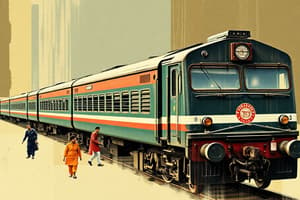Podcast
Questions and Answers
Which year was the first provisional State Railway Code for the Mechanical Department published?
Which year was the first provisional State Railway Code for the Mechanical Department published?
- 1991
- 1950
- 1944
- 1940 (correct)
What was the name of the code after its update in 2016?
What was the name of the code after its update in 2016?
- Mechanical Department Guidelines
- Indian Railway Code for the Mechanical Department
- Railway Board Manual
- Indian Railway Rolling Stock Code (correct)
The Indian Railway Rolling Stock Code supersedes all existing rules and orders.
The Indian Railway Rolling Stock Code supersedes all existing rules and orders.
True (A)
Who is the Secretary of the Railway Board as mentioned in the document?
Who is the Secretary of the Railway Board as mentioned in the document?
The year when the reprint edition of the State Railway Code was brought out is _____ .
The year when the reprint edition of the State Railway Code was brought out is _____ .
What does IRIMEE stand for?
What does IRIMEE stand for?
Which system is linked with wages and costing in the Indian Railway Rolling Stock Code?
Which system is linked with wages and costing in the Indian Railway Rolling Stock Code?
The main focus areas of the _____ are outlined in Chapter 1.
The main focus areas of the _____ are outlined in Chapter 1.
What is an essential service mentioned for workshop activities in the code?
What is an essential service mentioned for workshop activities in the code?
भारतीय रेलों की योजना में तीन स्तर क्या हैं?
भारतीय रेलों की योजना में तीन स्तर क्या हैं?
भारतीय रेलवे के वार्षिक रोलिंग स्टॉक कार्यक्रम में नई अधिग्रहण की प्राथमिकता है __________।
भारतीय रेलवे के वार्षिक रोलिंग स्टॉक कार्यक्रम में नई अधिग्रहण की प्राथमिकता है __________।
वार्षिक रोलिंग स्टॉक कार्यक्रम में प्रयुक्त सामग्री योजना से अधिक की जाती है।
वार्षिक रोलिंग स्टॉक कार्यक्रम में प्रयुक्त सामग्री योजना से अधिक की जाती है।
भारतीय रेलवे में रोलिंग स्टॉक की योजना कब बनाई जाती है?
भारतीय रेलवे में रोलिंग स्टॉक की योजना कब बनाई जाती है?
नीचे दिए गए उपकरणों को उनके कोडल जीवन के बाद मिलाएं:
नीचे दिए गए उपकरणों को उनके कोडल जीवन के बाद मिलाएं:
Flashcards
Chief Workshop Manager (CWM)
Chief Workshop Manager (CWM)
An organizational role responsible for overseeing all workshop activities, including production and maintenance.
Environment and Safety Manager (EnSM)
Environment and Safety Manager (EnSM)
The officer who manages the environmental and safety aspects within a workshop.
Gate Attendance System
Gate Attendance System
A system that uses technology like smart cards and biometrics to track employee attendance at entry and exit points.
Indian Railway Planning: Objectives
Indian Railway Planning: Objectives
Signup and view all the flashcards
Zonal Planning
Zonal Planning
Signup and view all the flashcards
Unit Level Planning
Unit Level Planning
Signup and view all the flashcards
Annual Rolling Stock Program (RSP)
Annual Rolling Stock Program (RSP)
Signup and view all the flashcards
New Acquisition under RSP
New Acquisition under RSP
Signup and view all the flashcards
Major Modifications under RSP
Major Modifications under RSP
Signup and view all the flashcards
Codal Life
Codal Life
Signup and view all the flashcards
Codal life of Electric Locomotives
Codal life of Electric Locomotives
Signup and view all the flashcards
Codal life of Diesel Hydraulic/Electric Locos
Codal life of Diesel Hydraulic/Electric Locos
Signup and view all the flashcards
Codal life of Electric Multiple Unit (EMU) Stock
Codal life of Electric Multiple Unit (EMU) Stock
Signup and view all the flashcards
Codal life of Coaching Vehicles
Codal life of Coaching Vehicles
Signup and view all the flashcards
Study Notes
Indian Railway Rolling Stock Code (October 2022)
- This code supersedes all previous Railway Board rules and orders on rolling stock production and maintenance. Deviations require Ministry of Railways sanction.
- The code was initially published in 1940 as the State Railway Code for the Mechanical Department, undergoing several revisions since then, most recently in 2022 incorporating feedback from IRIMEE and railway officers. It reflects updated techniques, incentive schemes (Group Incentive Scheme), biometric attendance, environmental management practices, and IT integration.
Chapter 1: Organization of Rolling Stock Production & Maintenance Department
- Outlines the organizational structure, including roles and responsibilities at various levels from the Railway Board and RDSO down to workshop supervisors.
- Key roles detailed include Chief Workshop Manager (CWM), Chemist and Metallurgist, Workshop Personnel Officer, Environment and Safety Manager (EnSM), Workshop Civil Engineer, Workshop Electrical Engineer, Dy.Chief Mechanical Engineer (Dy.CME)/Workshop Manager (WM), Workshop Accounts Officer, Dy.Chief Material Manager (Dy.CMM), Production Engineer, CME/Dy.CME(IT), Workshop Security Officer (WSO), and Workshop supervisors.
- Addresses topics such as workshop security, health units/hospitals, shop categorization, boiler maintenance, weigh bridge maintenance, staff strength and classification, customer orientation, disaster management, unitary command and control, and relevant acts and manuals.
- Annex 1.1 covers Mid-life rehabilitation (MLR).
Chapter 2: Production Units
- Details organization and costing systems within Indian Railways production units.
- Covers process costing, batch costing, cost classification (materials, overheads), work orders, component and assembly costing, cost reporting procedures (quarterly reviews, reports to GM and Railway Board), transfer pricing, and guidelines for rolling stock manufacture by repair workshops.
Chapter 3: Employees' Duties and Responsibilities
- Focuses on working hours, attendance systems (including the "Gate Attendance System," its modernization using smart cards and biometrics, and biometric gate attendance), time office procedures, handling of late attendance, work during meal hours and on Sundays, and supervisory staff attendance.
Indian Railway Planning: Objectives and Processes
- Aims to enhance service quality, passenger comfort, safety, punctuality, asset utilization, and cost reduction.
Planning Levels in Indian Railways
- Corporate Planning: Railway Board's five-year plan; forecasts infrastructure, asset, machinery & plant, and human resource needs; advises zonal railways on proposals.
- Zonal Planning: Meets zonal requirements.
- Unit Level Planning: Focuses on asset replacement and quality improvement.
Five-Year Plan and Annual Rolling Stock Program (RSP)
- Forecasts passenger and freight traffic growth, anticipates bottlenecks, determines rolling stock needs, plans for overaged asset replacement, and adopts state-of-the-art technology.
- RSP is a five-year plan follow-up, covering new acquisition and major modifications. Funded through capital expenditure (Demand 16, PH-21).
New Acquisition under RSP
- Includes locomotives, coaches, wagons, track machines, tower cars, breakdown cranes, and camping coaches. Planned and sanctioned at the Railway Board level.
Major Modifications under RSP
- Covers conversions (e.g., coaches to ART/ARME or camping coaches; air brake conversions); upgrades (Utkrisht coaches, Project Swarn); planned by zonal railways or the Railway Board, sanctioned at the board level.
High-Value Unit Exchange Spares
- Power packs, traction motors, compressors, and governors are procured under the Itemized Rolling Stock program, planned at the divisional/headquarters level and sanctioned by the Railway Board. Example: ALCO locomotive spare norms.
Rolling Stock Provisioning
- New rolling stock provisions are made three years in advance for locomotives and two years for wagons/carriages.
- Provisions can be for additional requirements or replacement/renewal.
- Replacement needs are projected based on likely condemnations.
- RSP is prepared 15–18 months in advance, using estimates; considers rolling stock due for renewal within 18 months of preparation (e.g., RSP 2020 covers renewals in 2022).
Codal Life of Rolling Stock
- Defined as the period a rolling stock operates economically and safely. (Railway Board's Letter No.: 99/M (N) /60/6 dated 11.5.99)
- Electric Locomotives: 35 years
- Diesel Hydraulic/Electric Locos:
- Original Power Pack: 30 years
- Renewed Power Pack: 40 years
- Power Pack: 20 years
- Battery Locomotives: 25 years
- Electric Multiple Unit Stock (Motor Coaches & Trailer Coaches): 25 years
- Coaching Vehicles: 30 years
- Bogie Inspection Carriages: 40 years
Studying That Suits You
Use AI to generate personalized quizzes and flashcards to suit your learning preferences.




